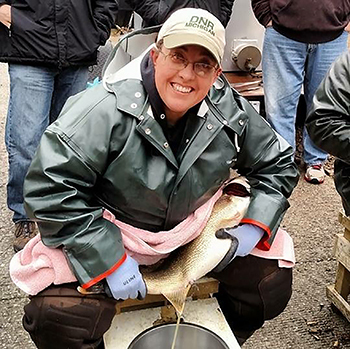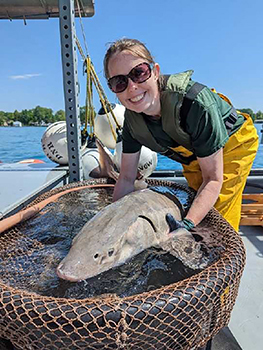Celebrating women in STEM with spotlight on DNR fisheries staff
By CASEY WARNER
Marketing and Outreach Division
Michigan Department of Natural Resources
As Women’s History Month kicks off, it’s a great time to celebrate women who are making history in the field of science.
While women remain underrepresented in STEM (science, technology, engineering and math) careers – constituting 48% of the total U.S. workforce but only 34% of the STEM workforce, according to the most recent State of Girls and Women in STEM report from the National Girls Collaborative Project – that gap is closing.

U.S. Census Bureau data shows that about 50 years ago, in 1970, women made up 38% of all U.S. workers but only 8% of STEM workers.
The Michigan Department of Natural Resources recently spotlighted, on DNR social media channels, some of the dedicated, accomplished women who help Michigan’s fisheries thrive, and what inspired them to pursue their passion. In honor of International Day of Women and Girls in Science, which took place Feb. 11, the post featured these employees’ reflections on why they got into the field of science.
"I went into the biological sciences field, because even as a young girl I had a strong curiosity about the natural world and especially water,” said Sara Thomas, manager of the DNR Fisheries Division’s Lake Erie Management Unit.
There are eight fisheries management units across Michigan, each responsible for setting regulations and making decisions for the waters in their portion of the state, both inland and Great Lakes. Each unit has fisheries biologists and technicians who do research, conduct surveys, work with fish hatcheries to make stocking decisions, set fishing regulations and work with their area research stations, all contributing to sound decision-making on how to manage Michigan’s fisheries.
“Now I can still pick up river rocks to see what aquatic insects are hiding underneath or catch fish, but I’m collecting valuable data and getting paid to do something I love!" Thomas said.
|

Jen Johnson is a fisheries biologist in the Northern Lake Michigan Management Unit.
"I was born and raised in the U.P., and as a kid I always loved being everywhere there was water and woods. I knew I wanted to be a fish biologist in third grade when I read a book about animals that live in the water,” Johnson said.
DNR fisheries biologists have a bachelor's degree in fisheries biology, fisheries management, aquatic biology or zoology. Their job description includes ensuring that the state's fisheries are appropriately maintained and that environmental conditions are suitable for the respective species.
“My curiosity about the aquatic world grew over time, and I think that what makes a great scientist – always asking questions,” Johnson said. “I love my career, and it is so rewarding for me to help manage the area I grew up in and to make sure it’s there for future generations to enjoy!"
|

Nicole Sherretz, lab technician at Platte River State Fish Hatchery in Beulah, echoed Johnson’s sentiments about a fascination with fish from a young age and a desire to ensure conservation of Michigan’s natural resources well into the future.
"Growing up fishing and hunting was a staple in our household; I happened to fall in love with everything about fish. So many of my fondest memories revolve around fishing with my family or solo trips,” Sherretz said. “I want to be a part of managing and helping sustain our amazing resources for generations to come."
|

Platte River is one of six DNR fish hatcheries, where fish eggs are hatched and the fry (baby fish) are raised, mostly to stock lakes, streams and ponds.
Another one, Wolf Lake State Fish Hatchery in Mattawan, is where Sadie Hallock works as a fisheries technician, whose duties include management support activities to protect, develop and maintain fish species for environmental and recreational purposes.
"I grew up camping and fishing, and that’s what led me to become very interested in pursuing an education and eventually a career in the field of fisheries,” Hallock said. “I love working hands-on at one of Michigan’s state fish hatcheries, raising fish that get to be stocked throughout the state. There is also the opportunity to go into the field to collect eggs or help other units with surveys.”
Lydia Doerr is a fisheries technician at the DNR Marquette Fisheries Research Station, whose staff conducts research and stock assessments on fish populations of Lake Superior and northern Lake Michigan.
|

"My love of science is as complex as the subject itself, and I cannot point to one moment that captured my heart,” Doerr said. “I was drawn to fisheries as it provides never-ending opportunities to appease my insatiable curiosity, while allowing me to work with fascinating animals in stunning locations with wonderful people."
Learn more about careers with the DNR at Michigan.gov/DNRJobs.
Not only does March mark Women’s History Month, it’s the start of a new license year. If reading this has inspired you to give fishing a try – or if you’re already an angler who’s ready to get out on the water again this year – you’ll need a new 2023 fishing license by the end of the month.
Visit Michigan.gov/Fishing for all the info you need about buying a license, regulations, where to fish and more.
Check out previous Showcasing the DNR stories at Michigan.gov/DNRStories. To subscribe to upcoming Showcasing articles, sign up for free email delivery at Michigan.gov/DNREmail.
|
Note to editors: Contact: John Pepin, Showcasing the DNR series editor, 906-226-1352. Accompanying photos and a text-only version of this story are available below for download. Caption information follows. Credit Michigan Department of Natural Resources, unless otherwise noted.
Text-only version of this story.
Doerr: Lydia Doerr, a fisheries technician at the Michigan Department of Natural Resources Marquette Fisheries Research Station.
Hallock: Sadie Hallock, a fisheries technician at the Michigan Department of Natural Resources Wolf Lake State Fish Hatchery in Mattawan.
Johnson: Jen Johnson, a fisheries biologist who works in the Michigan Department of Natural Resources Northern Lake Michigan Management Unit.
Muskie: Sadie Hallock, fisheries technician at the Michigan Department of Natural Resources Wolf Lake State Fish Hatchery, shown working on the hatchery’s efforts to collect thousands of muskies for stocking in bodies of water across the state.
Sherretz: Nicole Sherretz, a lab technician at the Michigan Department of Natural Resources Platte River State Fish Hatchery in Beulah.
Thomas: Sara Thomas, manager of the Lake Erie Management Unit for the Michigan Department of Natural Resources Fisheries Division.
|